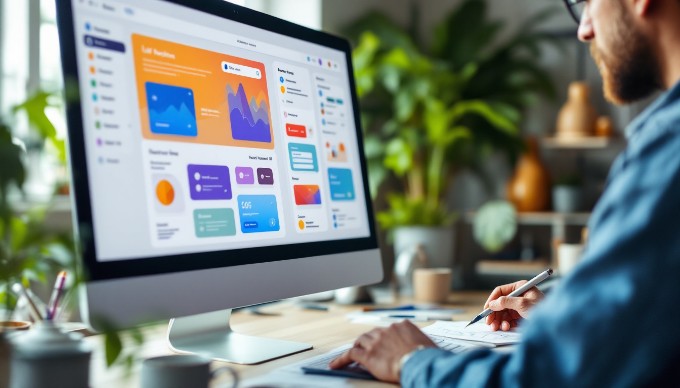What is flat UI – A comprehensive guide to flat design
Understanding flat UI design
In today’s digital landscape, understanding what is flat UI is essential for anyone involved in web and app design. Flat UI, or flat user interface, is a minimalist design style that emphasizes usability and simplicity by using clean, open space, crisp edges, and bright colors. Emerging as a response to the overly complex and skeuomorphic design trends of the early 2000s, flat UI strips away unnecessary embellishments, focusing instead on functionality and user experience. Unlike skeuomorphic designs that mimic real-world textures and objects, flat UI offers a more straightforward, modern aesthetic. This approach not only enhances load times and responsiveness but also aligns with the increasing demand for intuitive user interfaces. As you explore further, you’ll discover how flat UI contrasts with other design styles and why it remains a popular choice among designers today.

Key characteristics of flat UI
Flat UI, a popular design trend in web and app interfaces, stands out due to its clean and straightforward aesthetic. Here are some defining features that make flat UI unique:
One of the primary characteristics of flat UI is its minimalistic design. This approach strips away unnecessary decorative elements, focusing on simplicity and usability. By eliminating excessive textures and gradients, flat UI ensures that the user interface remains uncluttered and easy to navigate.
The use of vibrant colors is another hallmark of flat UI. Bright and bold color palettes are often employed to create visually appealing designs that capture user attention. These colors help differentiate elements, making it easier for users to interact with the interface.
Focus on typography is crucial in flat UI design. Since the design lacks intricate graphics, typography plays a significant role in conveying information and enhancing visual appeal. Designers often choose clean, sans-serif fonts that are both legible and modern.
Flat UI is also characterized by its lack of depth or shadows. Unlike skeuomorphic designs, which mimic real-world textures and shadows, flat UI embraces a two-dimensional look. This absence of depth helps maintain a sleek and modern appearance.
Responsive design elements are integral to flat UI, ensuring that interfaces adapt seamlessly across various devices and screen sizes. Key aspects of responsive design in flat UI include:
- Flexible grid systems that adjust to different screen dimensions
- Scalable icons and graphics that maintain clarity on all devices
- Touch-friendly elements that enhance usability on mobile devices
These characteristics collectively define what makes flat UI a favored choice among designers seeking to create intuitive and aesthetically pleasing user interfaces.
Expert graphic design services to elevate your brand. Book a call
Benefits of using flat UI
Flat UI design offers numerous advantages that contribute to its growing popularity in modern web and app development. Understanding these benefits can help you appreciate why many designers and developers choose this style. So, what is flat UI doing right? Let’s explore its key advantages.
Improved user experience
Flat UI is known for its clean and straightforward design, which enhances user experience. By eliminating unnecessary elements like gradients and shadows, users can focus more easily on content and navigation. This simplicity reduces cognitive load, making interfaces more intuitive and user-friendly.
Faster loading times
One of the significant benefits of using flat UI is its contribution to faster loading times. Since flat UI relies on simple graphics and avoids complex textures, the overall file sizes are reduced. This efficiency leads to quicker page loads, improving user satisfaction and retention.
Enhanced mobile compatibility
Flat UI design is particularly well-suited for mobile devices. Its minimalist approach ensures that interfaces look sharp and function smoothly on smaller screens. This compatibility is crucial in an era where mobile browsing is prevalent, ensuring a seamless experience across all devices.
Easier maintenance
Flat UI simplifies the maintenance process for developers. The lack of intricate design elements means fewer resources are needed to update and modify the interface. This ease of maintenance allows for quicker iterations and updates, keeping your platform current without extensive effort.
Better consistency across platforms
Consistency is key in delivering a cohesive user experience. Flat UI provides a uniform look and feel across different platforms and devices. This consistency helps build brand recognition and ensures that users have a familiar experience, regardless of how they access your content.
By leveraging these benefits, flat UI design can greatly enhance the overall effectiveness and appeal of digital products.
Popular applications of flat UI
Flat UI has become a dominant design trend due to its simplicity and effectiveness, finding applications across various digital and branding platforms. Its clean and minimalist approach makes it ideal for enhancing user experience in several areas.
Web design examples
Flat UI is widely used in web design to create visually appealing and user-friendly websites. Its emphasis on clean lines and bold colors helps users navigate sites with ease. Websites employing flat UI often feature:
- Simplified navigation menus
- Consistent typography
- Iconography that conveys meaning without unnecessary detail
These elements contribute to a streamlined browsing experience that keeps users engaged.
Mobile applications
The mobile application industry has embraced flat UI for its ability to enhance functionality and speed. On smaller screens, this design style is particularly effective in:
- Reducing visual clutter
- Enhancing readability
- Improving load times due to simpler graphics
Flat UI ensures that mobile apps remain intuitive and efficient, catering to users’ needs for seamless interaction.
Software interfaces
Software interfaces benefit greatly from flat UI by providing users with straightforward, efficient interactions. This design approach helps in:
- Simplifying complex processes
- Highlighting essential features
- Creating a more intuitive user journey
The emphasis on usability in flat UI supports software developers in delivering products that are both functional and aesthetically pleasing.
Branding and marketing materials
Flat UI is not limited to digital interfaces; it also plays a crucial role in branding and marketing materials. Its bold, clear style is ideal for:
- Creating memorable logos
- Designing eye-catching advertisements
- Developing cohesive brand identities
By using flat UI, brands can communicate their message more effectively and create a strong visual presence.
Social media platforms
Social media platforms utilize flat UI to foster engaging and interactive environments. This design trend aids in:
- Streamlining user interfaces
- Enhancing content visibility
- Ensuring consistency across different devices
The adoption of flat UI in social media helps platforms maintain a modern look while supporting user interaction and content sharing.
In conclusion, flat UI’s versatility makes it a popular choice across various applications, from web design to branding. Its focus on simplicity and functionality continues to drive its widespread adoption in the digital landscape.
Future trends in flat UI design
Flat UI design has come a long way since its inception, evolving to meet the demands of modern users and technologies. As we look to the future, several trends are shaping the way flat design is implemented and integrated across digital platforms.
Evolution of flat design
Flat UI design has continuously evolved to enhance user experience and interface aesthetics. Initially characterized by simplicity and minimalism, it now incorporates more dynamic elements to maintain user engagement. This evolution includes:
- The use of subtle gradients and shadows to add depth while maintaining flat design principles
- Incorporating more vibrant color palettes to create a visually appealing interface
- Enhancing typography to improve readability and support brand identity
Integration with other styles
Designers are increasingly blending flat UI with other design styles to create unique and effective user interfaces. This integration allows for more flexibility and creativity in design. Key integrations include:
- Combining flat design with 3D elements to offer a more immersive experience
- Merging flat design with material design principles for added functionality
- Using flat design with neumorphism to introduce a soft, tactile feel
Impact of technology on design
Advancements in technology significantly influence flat UI design, encouraging innovation and adaptation. Technologies such as artificial intelligence and augmented reality are starting to play a role in design trends:
- AI-driven design tools enable more personalized user experiences
- Augmented reality applications are incorporating flat UI elements for seamless user interaction
- The rise of responsive design ensures flat UI remains effective across various devices and screen sizes
User preferences
User preferences are crucial in guiding the future of flat UI design. As users become more accustomed to digital interfaces, their expectations evolve, prompting designers to adapt accordingly:
- A growing preference for intuitive and fast-loading interfaces that flat design can provide
- Demand for accessibility features, pushing flat design to become more inclusive
- User feedback driving continuous refinement and innovation in design elements
Case studies of successful implementations
Several companies have successfully implemented flat UI design, showcasing its effectiveness and versatility. These case studies highlight how flat design can meet diverse business needs:
- Companies like Apple and Google have utilized flat design to create intuitive and engaging user interfaces
- Startups and small businesses leverage flat design for cost-effective, scalable digital solutions
- E-commerce platforms benefit from flat UI by offering streamlined navigation and improved user experience
As flat UI design continues to adapt and grow, it remains a powerful tool for creating modern, user-friendly interfaces. By staying attuned to technological advancements and user preferences, designers can leverage flat design to its fullest potential.

Conclusion – Embracing flat UI in modern design
In conclusion, understanding what is flat UI is crucial for anyone looking to create modern, efficient, and visually appealing digital interfaces. Throughout the article, we explored how flat UI design emphasizes simplicity and functionality by utilizing clean lines, ample whitespace, and a minimalist aesthetic. We discussed its advantages, such as faster load times and improved user experience, which are pivotal in today’s fast-paced digital world. Flat UI’s straightforward approach not only enhances the aesthetic appeal but also facilitates intuitive navigation, making it an ideal choice for web and mobile applications.
As you consider implementing flat UI principles in your projects, remember that its effectiveness lies in its ability to prioritize content and usability. We encourage you to explore the various aspects of flat design further and experiment with incorporating these elements into your own designs. By doing so, you can stay ahead of design trends and create user interfaces that are both functional and visually engaging. Embrace the simplicity and efficiency of flat UI, and watch as your digital platforms transform into seamless, user-friendly experiences.
Boost Engagement with Conversion-Driven Design
Enhance usability with optimized designs that convert users into customers.
Learn More